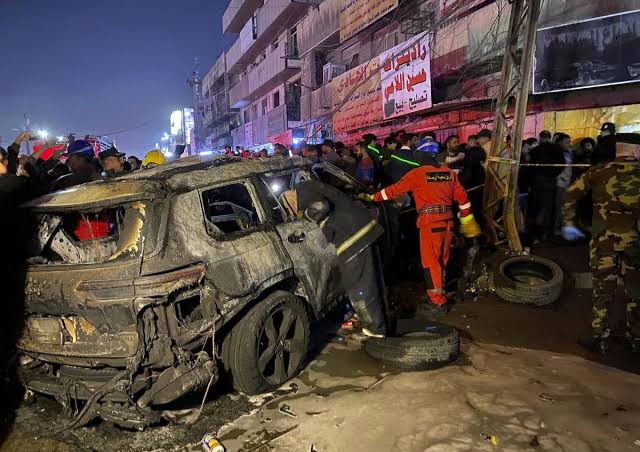The killing of a leader of Kata’ib Hezbollah continued a series of strikes in retaliation for attacks on U.S. troops in the region, including one that killed three Americans in Jordan.
A drone strike carried out by U.S. Special Operations in the Iraqi capital on Wednesday resulted in the death of a high-ranking leader of a militia group according to the Pentagon. The strike was a response to recent assaults on American personnel in line with President Biden’s commitment to address the series of attacks by Shiite militias.
The Pentagon identified the deceased as a senior figure of Kata’ib Hezbollah the same militia believed to have orchestrated a drone attack in Jordan last month that claimed the lives of three American service members and left over 40 others injured. Described as a “dynamic” operation the strike targeted the militia commander who had been under surveillance by American intelligence for a considerable period. Another U.S. official emphasized that the decision to conduct the strike was made in defense of American interests and reiterated the nation’s prerogative to employ such measures when deemed necessary.
Videos from the scene showed the wreckage of a vehicle in a neighborhood of eastern Baghdad and a nearby fire.
According to statements from a senior Kata’ib Hezbollah official and Iran’s Revolutionary Guards Corps two commanders were reportedly killed in the drone strike. Witnesses at the scene mentioned discovering identification cards nearby which purportedly belonged to the deceased individuals identified as Arkan al-Elayawi and Abu Baqir al-Saedi.
Following the strike crowds gathered in the streets of Baghdad expressing discontent with chants such as “America is the devil.”
Maj. Gen. Tahsin al-Khafaji a spokesman for Iraq’s security services criticized the strike as an act of aggression emphasizing that it infringed upon Iraqi sovereignty and posed potential risks of escalating tensions in the region.

Wednesday’s strike occurred after a period of relative calm in the Middle East subsequent to American military actions on Friday and Saturday, which marked the beginning of what President Biden and his administration have described as an ongoing campaign of retaliation.
On Monday, the Pentagon provided an update stating that American warplanes had effectively neutralized a significant portion of the Iranian and militia targets targeted during the airstrikes conducted in Syria and Iraq on Friday.
Maj. Gen. Patrick S. Ryder of the Pentagon reported that the U.S. military successfully neutralized “more than 80” out of approximately 85 identified targets across Syria and Iraq. These targets encompassed various vital installations including command centers, intelligence facilities, rocket and missile depots, as well as storage areas for attack drones, logistics and ammunition. Among these, Kata’ib Hezbollah, stationed in Iraq, stands out as a significant entity perceived as a proxy extension of Iran and labeled a terrorist organization by the U.S. government.
The U.S. attributes a surge in rocket and drone attacks targeting its troops in Iraq and Syria to Iran and the allied militias citing escalated tensions since the commencement of the conflict between Hamas and Israel in early October. In response the Biden administration has pursued calculated airstrikes aimed at deterring these groups while avoiding an escalation into broader armed conflict.
Following a drone strike on a secluded base in Jordan on January 28th, resulting in the deaths of three American service members, administration officials highlighted a critical threshold being breached. President Biden pledged an ongoing robust response to the incident. Subsequently, Kata’ib Hezbollah announced a cessation of hostilities against American forces reportedly influenced by Iraq and Iran’s governments, illustrating Iran’s hesitance to engage directly with the United States. However other factions participating in similar assaults have not demonstrated a willingness to abide by comparable agreements.
The ongoing exchanges of attacks across Syria, Iraq, and Jordan, coupled with the reciprocal strikes between the United States and the Iran-aligned Houthis in Yemen have heightened tensions in the region moving it perilously close to a broader conflict. Despite affirmations from the administration that it seeks to avoid war with Iran the focus remains on diminishing the substantial arsenals of the militias and dissuading further assaults on U.S. troops and merchant vessels in the Red Sea. By targeting leaders of Kata’ib Hezbollah the administration aims to convey a resolute message to Iran and its allied militias that any loss of American lives will prompt a robust response.
In January, the Pentagon disclosed the killing of a commander from another Iraqi militia, Haraqat al Nujaba, implicated in orchestrating attacks against American personnel in the region. National security experts and officials privately acknowledge that a sustained campaign akin to the protracted effort against the Islamic State would be necessary to truly degrade the capabilities of Iran-backed militias.
Despite these efforts, officials suggest that the militias, supported by Iran, might endure longer than the Islamic State which faced pressure from the United States, Iran, and Russia. Additionally, the United States would need to focus on eliminating a larger number of senior leaders and commanders to effectively weaken the militias.










